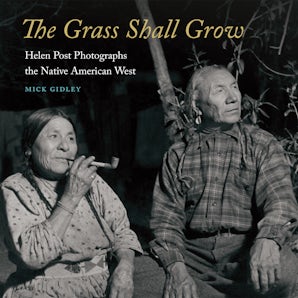"This book is full of such keen insights and information and excellent photographic reproductions. It is an excellent and needed addition to the scholarship on Helen Post—whose work deserves greater recognition—and twentieth-century photographs of Native Americans in the American Southwest."—Devorah Romanek, New Mexico Historical Review
"Gidley's book brings to light important work by a talented photographer who has been largely lost to history until now. It is a valuable addition to scholarship on photography of Native Americans, the Great Plains, and the New Deal era."—Cara A. Finnegan, Great Plains Quarterly
"The Grass Shall Grow will be interesting to a wide variety of readers, with an accessible narrative a fascinating images."—Rachel McLean Sailor, South Dakota History
"Scholars whose work touches on photographic representation, the New Deal era, or the federal-tribal relationship will find much useful information in this work."—Angela Parker, Native American and Indigenous Studies
"I just finished reading The Grass Shall Grow: Helen Post Photographs the Native American West, and I am delighted with Mick Gidley’s interpretation of my mother’s work. It really cements Helen Post’s place in twentieth century photographic history. I am a very special audience for this book, because I am deeply personally invested in the documentation of my mother’s place in photography, and because I know so much about many of the characters and history embodied in it. But my knowledge is incomplete, it is like a big jigsaw puzzle with missing pieces. I have gleaned much of the history of her assignments photographing Native Americans from the surviving prints, negatives and paper records, the bulk of which I gave to the Amon Carter Museum, and from her fragmentary reminiscences told over the years. Yet I could never have assembled it into a coherent whole as Dr. Gidley did with his extensive research. For that I am deeply grateful. I will recommend it to all our friends who remember Helen and are interested in her work. Congratulations on the publication of a very welcome work! And I might add, it is very well written and was a pleasure to read."—Peter Modley, son of Helen Post (Modley)
“The Grass Shall Grow resurrects the work of photographer Helen Post, an important if little-known photographer, whose work in Indian Country during the late 1930s and early 1940s complements the better known-work by photographers connected to the Farm Security Administration (FSA). Focusing on sites overlooked by the FSA, Post pictured communities from Arizona to Montana. In Gidley’s book she finally gets her due as an independent woman, well informed about Indian policy, who sought to capture a respectful and empathetic image of Native life during the Great Depression.”—Martha A. Sandweiss, professor of history at Princeton University and author of Print the Legend: Photography and the American West
